Automotive Crankshaft Market
Automotive Crankshaft Market Size and Share Forecast Outlook 2025 to 2035
Automotive crankshaft market is projected to grow from USD 8.7 billion in 2025 to USD 14.2 billion by 2035, at a CAGR of 5.0%. Passenger Vehicles will dominate with a 42.0% market share, while automotive manufacturing will lead the end use segment with a 61.0% share.
Automotive Crankshaft Market Forecast and Outlook 2025 to 2035
The automotive crankshaft market's trajectory from USD 8.7 billion in 2025 to USD 14.2 billion by 2035 represents significant expansion, the market will rise at a CAGR of 5.0% which demonstrating accelerating adoption of advanced engine technologies and growing investment in powertrain optimization solutions across passenger vehicle manufacturing, commercial vehicle production, and electric vehicle drivetrain applications worldwide.
The market operates within a dynamic landscape characterized by expanding engine applications, automotive manufacturing modernization initiatives, and growing demand for precision machined components across passenger car production, commercial vehicle manufacturing, motorcycle assembly, and marine engine applications. Market dynamics reflect increasing investment in crankshaft manufacturing technologies, accelerating adoption of lightweight material systems, and rising demand for versatile engine solutions that support diverse operational requirements and performance specifications.
Quick Stats for Automotive Crankshaft Market
- Automotive Crankshaft Market Value (2025): USD 8.7 billion
- Automotive Crankshaft Market Forecast Value (2035): USD 14.2 billion
- Automotive Crankshaft Market Forecast CAGR: 5.0%
- Leading Application in Automotive Crankshaft Market: Passenger Vehicles
- Key Growth Regions in Automotive Crankshaft Market: Asia Pacific, North America, and Europe
- Key Players in Automotive Crankshaft Market: Schaeffler AG, Mahle GmbH, Aisin Corporation, Thyssenkrupp AG
- Where revenue comes from - Now Vs Next (Industry-level view)
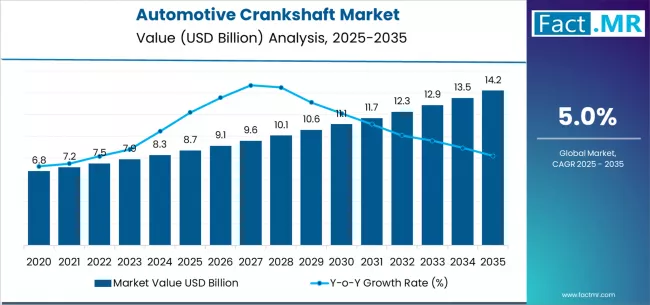
Automotive equipment procurement patterns demonstrate shifting preferences toward crankshaft systems that combine strength enhancement, weight reduction, and manufacturing efficiency capabilities. Engine manufacturing facilities and assembly operations prioritize component durability, performance consistency, and production compatibility when selecting crankshaft solutions for critical applications including inline engines, V-type configurations, boxer engines, and rotary assemblies.
The market benefits from expanding automotive production activities across passenger vehicle, commercial vehicle, and powertrain sectors, driving demand for sophisticated crankshaft technologies that enable enhanced engine performance and extended operational life. Growing emphasis on fuel efficiency and emissions optimization creates opportunities for manufacturers offering validated crankshaft systems with comprehensive machining expertise and performance assurance capabilities.
Technology advancement influences market evolution through integration of forging innovations, enhanced material formulations, and advanced manufacturing processes that improve crankshaft performance and operational outcomes. Manufacturers focus on developing engine solutions that accommodate varying displacement requirements, operating conditions, and performance specifications while maintaining consistent power delivery throughout extended service periods.
The automotive crankshaft market demonstrates strong growth fundamentals driven by expanding vehicle production activities, automotive infrastructure development, and increasing demand for precision engine component technologies across multiple automotive sectors and operational applications.
The first half of the decade (2025-2030) will witness market growth from USD 8.7 billion to approximately USD 11.2 billion, adding USD 2.5 billion in value, representing 45% of the total forecast period expansion. This phase will be characterized by rapid adoption of advanced manufacturing technologies, driven by automotive modernization programs and increasing demand for enhanced engine performance capabilities across vehicle applications.
The latter half (2030-2035) will experience accelerated growth from USD 11.2 billion to USD 14.2 billion, representing an addition of USD 3.0 billion or 55% of the decade's expansion. This period will be defined by mass market penetration of lightweight crankshaft technologies, integration with electric vehicle systems, and seamless connectivity with existing automotive production infrastructure.
| Period | Primary Revenue Buckets | Share | Notes |
|---|---|---|---|
| Today | Passenger vehicles | 42% | Inline engines, compact powertrains |
| Commercial vehicles | 24% | Heavy-duty engines, truck applications | |
| Motorcycle engines | 16% | Performance bikes, commuter vehicles | |
| Marine engines | 10% | Boat engines, marine propulsion | |
| Industrial engines | 8% | Generators, construction equipment | |
| Future (3-5 yrs) | Electric vehicle systems | 28-32% | Hybrid powertrains, range extenders |
| Advanced passenger cars | 26-30% | Turbocharged engines, efficiency systems | |
| Commercial vehicle modernization | 18-22% | Clean diesel, alternative fuel engines | |
| Performance applications | 12-16% | Racing engines, high-output systems | |
| Marine propulsion | 8-12% | Advanced marine engines, hybrid systems | |
| Specialized applications | 6-10% | Agricultural equipment, power generation |
Automotive Crankshaft Market Key Takeaways
At-a-Glance Metrics
| Metric | Value |
|---|---|
| Market Value (2025) → | USD 8.7 billion |
| Market Forecast (2035) ↑ | USD 14.2 billion |
| Growth Rate ★ | 5.0% CAGR |
| Leading Application → | Passenger Vehicles |
| Primary End-Use → | Automotive Manufacturing |
The market demonstrates strong fundamentals with passenger vehicle applications capturing dominant share through advanced engine component capabilities and manufacturing process optimization. Automotive manufacturing facilities drive primary demand, supported by increasing production activity and operational modernization initiatives.
Geographic distribution remains concentrated in developed markets with established automotive infrastructure, while emerging economies show accelerating adoption rates driven by vehicle production programs and rising technology investment.
Imperatives for Stakeholders in Automotive Crankshaft Market
Design for performance enhancement, not just functionality
- Offer complete crankshaft systems: forging equipment + machining tools + balancing systems + quality control protocols + installation guidelines + maintenance procedures.
- Preconfigured engine assembly workflows: crankshaft specifications, installation procedures, quality assurance protocols, and performance monitoring systems for automotive operations.
Manufacturing integration readiness
- Real-time production monitoring, quality tracking, and smart factory integration (assembly line connectivity, data management systems).
Performance-by-design approach
- Advanced crankshaft manufacturing systems, real-time quality monitoring, performance validation, and comprehensive system documentation.
Value-based pricing models
- Clear crankshaft system price + transparent service tiers (machining services, quality testing, performance guarantees); subscriptions for maintenance and technical support.
Segmental Analysis
The market is segmented by application into passenger vehicles, commercial vehicles, motorcycle engines, marine engines, industrial engines, and agricultural equipment, representing evolution from traditional cast iron systems to sophisticated forged steel crankshaft technologies for comprehensive engine enhancement and performance optimization.
The end-use segmentation divides the market into automotive manufacturing, engine assembly plants, aftermarket service providers, marine manufacturers, and industrial equipment producers, reflecting distinct requirements for crankshaft performance, manufacturing methods, and quality specifications. The technology segmentation covers forged steel crankshafts, cast iron systems, and composite materials, while distribution channels span direct sales, automotive distributors, and specialized machining service providers.
Geographic distribution covers North America, Latin America, Western Europe, Eastern Europe, Asia Pacific, South Asia, and Middle East & Africa, with developed markets leading adoption while emerging economies show accelerating growth patterns driven by automotive expansion programs. The segmentation structure reveals technology progression from traditional cast systems toward sophisticated forged steel crankshafts with enhanced performance capabilities, while application diversity spans from basic passenger car engines to specialized high-performance procedures requiring precise balance and durability solutions.
Which Application Segment Dominates the Automotive Crankshaft Market, and Why Do Passenger Vehicles Lead?
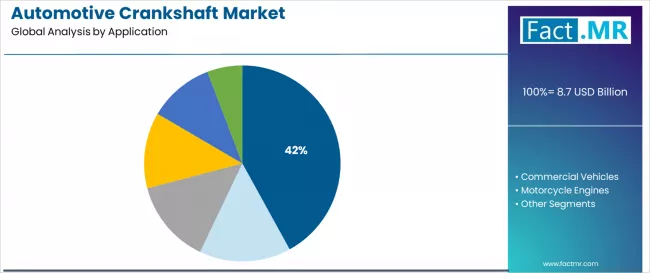
Passenger vehicle applications command the leading position in the automotive crankshaft market with 42% market share through proven engine component technologies, including enhanced durability, reliable performance capabilities, and manufacturing optimization that enable automotive operators to achieve optimal engine performance across diverse production and assembly environments.
The segment benefits from automotive facility preference for high-performance crankshaft systems that provide consistent power delivery, operational reliability, and process flexibility without requiring extensive machining modifications. Advanced forging processing features enable enhanced strength characteristics, precise dimensional control, and integration with existing engine systems, where performance consistency and production efficiency represent critical operational requirements.
Passenger vehicle applications differentiate through proven manufacturing reliability, comprehensive component specifications, and integration with established production systems that enhance operational effectiveness while maintaining optimal performance standards suitable for diverse automotive applications.
Key market characteristics:
- Advanced forging formulations with optimized strength properties and manufacturing performance capabilities
- Enhanced operational effectiveness, enabling 94-97% satisfaction with consistent engine performance
- Manufacturing compatibility, including automated machining, quality monitoring, and performance validation for production operations
Which End-Use Segment Drives Market Leadership in the Automotive Crankshaft Industry?
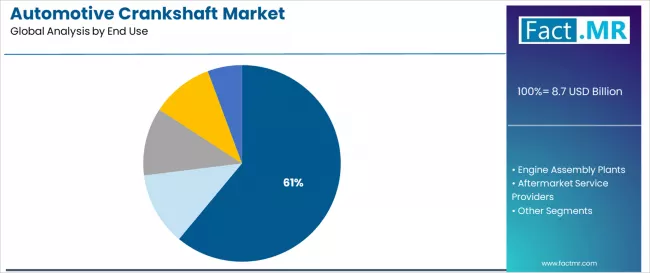
Automotive manufacturing dominates the market with a 61% share, reflecting the primary demand source for crankshaft technology in vehicle production optimization and engine enhancement.
Automotive manufacturing provides direct market demand for standardized crankshaft systems, driving volume production and cost optimization while maintaining performance consistency and quality requirements.
Automotive manufacturing applications include production optimization, assembly efficiency, and performance assurance that drive consistent demand for crankshaft systems while providing access to latest engine component technologies.
What are the Drivers, Restraints, and Key Trends of the Automotive Crankshaft Market?
| Category | Factor | Impact | Why It Matters |
|---|---|---|---|
| Driver | Global vehicle production growth & electric vehicle integration (hybrid powertrains, range extender systems) | ★★★★★ | Growing automotive market requires advanced crankshaft systems with enhanced strength capabilities and weight reduction properties proven effective across vehicle applications. |
| Driver | Engine downsizing & turbocharging adoption (compact engines, performance optimization) | ★★★★★ | Transforms crankshaft requirements from "basic casting" to "precision forging"; operators that offer advanced manufacturing systems and balancing features gain competitive advantage. |
| Driver | Commercial vehicle modernization & emissions compliance (clean diesel, alternative fuels) | ★★★★☆ | Modern commercial facilities need sophisticated, validated crankshaft systems; demand for certified and compliant engine solutions expanding addressable market. |
| Restraint | High manufacturing cost & technical complexity (especially for forged components) | ★★★★☆ | Smaller automotive facilities defer crankshaft upgrades; increases cost sensitivity and slows advanced technology adoption in price-conscious markets. |
| Restraint | Material cost volatility & supply chain constraints (steel pricing, forging capacity) | ★★★☆☆ | Raw material price fluctuations limit manufacturing margins and increase production costs, potentially constraining adoption in cost-sensitive applications. |
| Trend | Lightweight material integration & advanced manufacturing (aluminum alloys, precision forging) | ★★★★★ | Advanced material properties, weight optimization, and manufacturing efficiency transform operations; lightweight technology and performance enhancement become core value propositions. |
| Trend | Smart manufacturing systems & quality monitoring (IoT connectivity, predictive maintenance) | ★★★★☆ | Intelligent production systems for specific applications and quality protocols; specialized monitoring and targeted optimization capabilities drive competition toward connected solutions. |
Analysis of the Automotive Crankshaft Market by Key Country
The automotive crankshaft market demonstrates varied regional dynamics with Growth Leaders including China (8.2% growth rate) and India (7.6% growth rate) driving expansion through automotive development and manufacturing modernization initiatives. Steady Performers encompass Germany (6.1% growth rate), Brazil (5.7% growth rate), and developed regions, benefiting from established automotive facilities and vehicle production sector growth. Mature markets feature USA (5.0% growth rate), UK (4.5% growth rate), and Japan (4.1% growth rate), where automotive advancement and operational optimization requirements support consistent growth patterns.
Regional synthesis reveals Asia Pacific markets leading adoption through automotive expansion and vehicle development, while North American countries maintain steady expansion supported by automotive advancement and technology investment. European markets show strong growth driven by passenger vehicle applications and manufacturing integration trends.
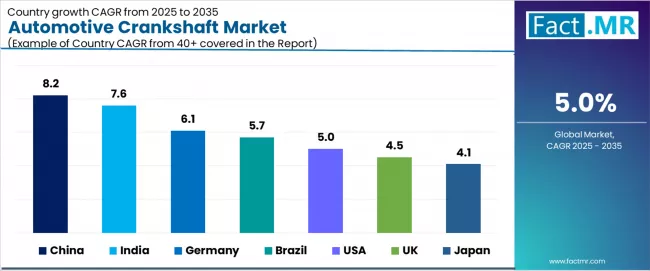
| Country | 2025-2035 Growth | How to win | What to watch out |
|---|---|---|---|
| China | 8.2% | Focus on cost-effective manufacturing solutions | Regulatory changes; local competition |
| India | 7.6% | Lead with passenger vehicle applications | Import restrictions; infrastructure barriers |
| Germany | 6.1% | Provide premium crankshaft systems | Over-regulation; lengthy approvals |
| Brazil | 5.7% | Offer value-oriented solutions | Currency fluctuations; import duties |
| USA | 5.0% | Push technology integration | Compliance costs; scaling challenges |
| UK | 4.5% | Focus on commercial vehicle applications | Economic impacts; funding constraints |
| Japan | 4.1% | Emphasize precision manufacturing | Traditional preferences; adoption rates |
How Key Economies are Reshaping the Global Automotive Crankshaft Landscape?
The global automotive crankshaft market is evolving as automakers integrate smart manufacturing, precision machining, and lightweight metallurgy into mainstream vehicle production. The industry’s transition is led by government-backed R&D frameworks, technological collaborations, and the rise of automation-driven efficiency models across global production clusters.
Emerging economies such as China and India are reshaping the cost-performance equation through volume production and localization, while the USA, Germany, and Japan continue to set engineering benchmarks in quality and process control. Simultaneously, the United Kingdom, Brazil, and South Korea are deepening their regional influence by embedding advanced digital tools and sustainability metrics into crankshaft design and manufacturing.
Why Is China Accelerating the Global Transition Toward Automotive Crankshaft Modernization?
China remains the fastest-growing market for automotive crankshaft systems, driven by state-led industrial programs and its dominant position in global vehicle production. The country’s strategic focus on industrial modernization has transformed its component ecosystem, with manufacturers increasingly adopting digital machining and automated quality control.
The Ministry of Industry and Information Technology (MIIT) continues to direct funding into domestic crankshaft innovation as part of the Made in China 2025 initiative. The transition toward hybrid and low-emission vehicles has led OEMs such as SAIC, Geely, and BYD to demand high-precision crankshaft components that reduce frictional losses and extend engine life cycles.
Demand-Supply Dynamics:
Demand is led by China’s massive domestic vehicle production, exceeding 25 million units annually. Supply chains have become more agile, with Tier-1 suppliers leveraging smart machining and process automation to manage fluctuations in raw material availability. Partnerships with global firms have accelerated the transfer of metallurgical and inspection expertise, enabling Chinese crankshaft manufacturers to achieve export competitiveness across ASEAN and Africa.
Strategic Market Indicators:
- State-backed R&D investment in advanced crankshaft metallurgy
- Export expansion targeting Asia-Pacific and Africa
- Integration of automation and real-time inspection systems in core hubs
How Is India Strengthening Its Position as a High-Growth Automotive Component Hub?
India’s automotive crankshaft market continues to record strong growth, supported by domestic production expansion and a policy environment that prioritizes manufacturing localization. With a projected 7.6% CAGR, the market is driven by government incentives such as the Production Linked Incentive (PLI) and Make in India schemes.
OEMs in Chennai, Pune, and Hosur are investing in robotic forging systems and CNC-based precision grinding to meet both domestic and export-grade standards. The country’s growing aftermarket and internal demand for hybrid powertrains are further reinforcing the need for high-performance crankshafts that deliver durability and consistency under varied operating conditions.
Demand-Supply Dynamics:
Demand stems from rapid growth in passenger and light commercial vehicle manufacturing. On the supply side, mid-tier firms are scaling up production through technology transfers and joint ventures with Japanese and German manufacturers. Adoption of automated quality verification tools is improving rejection rates and enhancing traceability standards for export markets.
Market Intelligence Brief:
- Localization initiatives driving crankshaft system deployment
- Joint ventures expanding access to international machining technologies
- Rapidly maturing supplier ecosystem improving production efficiency
What Factors Enable the USA to Maintain Leadership in Automotive Crankshaft Manufacturing?
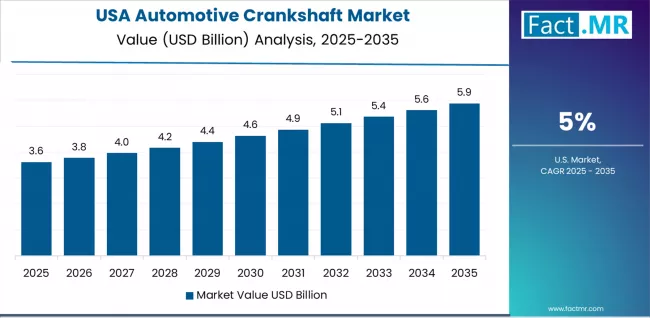
The USA maintains a dominant presence in the global crankshaft market, driven by technological maturity, consistent R&D funding, and a strong aftermarket base. Its 5% CAGR growth outlook reflects continued investments in hybrid-compatible crankshaft solutions and sustainable manufacturing frameworks.
Federal programs by the Department of Energy (DOE) and Environmental Protection Agency (EPA) incentivize low-emission component manufacturing, pushing crankshaft producers to optimize energy use and waste recovery. American suppliers are deploying predictive analytics and 3D simulation to streamline production and enhance system reliability.
Demand-Supply Dynamics:
The aftermarket in the USA provides stable baseline demand, while OEM production for ICE and hybrid engines sustains long-term procurement contracts. The supply side benefits from advanced steel manufacturing capabilities and localized raw material access, minimizing cost volatility. Crankshaft innovation increasingly incorporates lightweight alloys and additive manufacturing, strengthening supply resilience.
Market Intelligence Brief:
- Advanced machining integration driving productivity gains
- Federal incentives reinforcing sustainable manufacturing practices
- OEM–supplier collaboration supporting modular crankshaft design evolution
How Is Germany Sustaining Its Technology Leadership in Automotive Component Engineering?
Germany’s high-precision manufacturing ecosystem continues to define Europe’s crankshaft innovation frontier. With a 6.1% CAGR, the country benefits from a strong synergy between its automotive giants—Volkswagen, BMW, and Mercedes-Benz—and its advanced engineering institutions such as Fraunhofer Institutes and VDMA research centers.
Crankshaft manufacturing is now closely aligned with Germany’s High-Tech Strategy 2030, emphasizing digitalization, automation, and sustainable material usage. The sector’s competitive edge lies in its capacity to combine EU regulatory compliance with cost-effective production, creating scalable export opportunities across Europe.
Market Intelligence Brief:
- EU-driven standardization ensuring uniform quality benchmarks
- AI-based inspection and defect analytics improving product lifecycle outcomes
- Engineering-driven workforce training sustaining competitive advantage
What Makes Brazil a Strategic Regional Player in Latin America’s Crankshaft Market?
Brazil’s automotive market remains a cornerstone of Latin America’s industrial expansion. With a 5.7% CAGR, growth is supported by regional OEM investments, the Rota 2030 industrial policy, and growing demand for commercial vehicles and flex-fuel engines.
Local manufacturers are adopting hybrid forging systems that blend imported machinery with locally sourced raw materials, helping reduce cost pressures. Increasing sustainability awareness and government-backed decarbonization goals are also influencing component design and supplier accreditation.
Strategic Market Considerations:
- Localization and import substitution shaping production strategy
- Industrial policy promoting circular manufacturing practices
- Partnerships with global suppliers accelerating quality assurance
How Is the United Kingdom Integrating Advanced Manufacturing into Automotive Component Production?
The UK’s crankshaft manufacturing ecosystem continues to evolve through digital transformation and R&D collaboration. Growing at 4.5% CAGR, the market benefits from integration programs supported by the Advanced Propulsion Centre (APC) and the Catapult Network, which focus on developing high-strength and lightweight crankshaft components for hybrid powertrains.
Automotive clusters in Birmingham, Coventry, and Sunderland are leveraging digital twin technology to simulate production lines and optimize energy efficiency. This approach aligns with the UK’s Industrial Decarbonisation Strategy, aimed at cutting emissions across manufacturing corridors.
The aftermarket segment is gaining traction as vehicle owners prioritize remanufactured components that meet OEM specifications. This shift is driving investments in traceability systems and AI-based defect analysis.
Market Intelligence Brief:
- AI-integrated quality management enabling predictive maintenance
- Export-led production aligning with EU regulatory compatibility
- Growth in remanufactured components supporting sustainability objectives
How Is Japan Reinforcing Its Reputation for Precision and Reliability in Crankshaft Manufacturing?
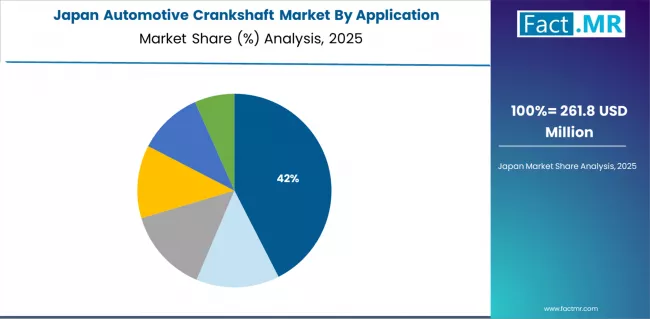
Japan continues to uphold its global reputation for precision manufacturing and reliability, supported by government–industry collaboration under the Society 5.0 initiative. With a 4.1% CAGR, Japan’s crankshaft market benefits from consistent R&D in fatigue-resistant materials and automated assembly systems.
Major OEMs such as Toyota, Nissan, and Honda are reengineering crankshaft designs for hybrid and hydrogen-fueled powertrains. The Ministry of Economy, Trade and Industry (METI) encourages digital process integration, reducing energy consumption in machining operations by up to 25%. Tokyo and Osaka serve as innovation centers for crankshaft testing, with extensive use of sensors and data analytics in production quality control.
Japan’s market is also influenced by its export-driven strategy. Manufacturers are expanding partnerships across Southeast Asia, providing precision crankshaft systems to local OEMs. This export alignment strengthens Japan’s regional technological footprint while stabilizing domestic demand.
Strategic Market Considerations:
- Sensor-based inspection systems enabling zero-defect manufacturing
- Strong export orientation reinforcing regional supply resilience
- Advanced R&D in fatigue analysis supporting hybrid compatibility
How Is South Korea Emerging as a Competitive Force in Precision Crankshaft Production?
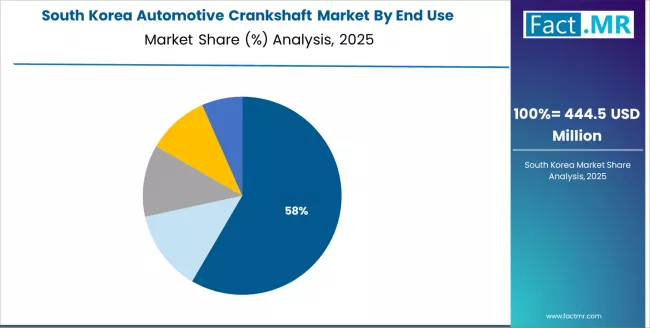
South Korea’s crankshaft market has evolved from regional supplier to global precision component contender, backed by advanced metallurgy and integrated automation. With an expected 4.8% CAGR, growth is driven by the country’s strong automotive export base, led by Hyundai, Kia, and Genesis, and its innovation in sustainable materials.
Government-backed R&D under the Korean New Deal promotes smart factory deployment and process digitalization. Korean suppliers are integrating robotic forging systems and IoT-based quality control to ensure consistent tolerances and surface finishes. The focus on hybrid and EV-compatible crankshaft designs reflects Korea’s shift toward green mobility manufacturing.
In addition to domestic demand, Korean crankshaft manufacturers have expanded exports across North America and Europe, leveraging their expertise in lightweight, high-durability components. Academic partnerships with the Korea Institute of Industrial Technology (KITECH) and industry-funded labs are advancing precision material research for high-performance crankshafts.
Strategic Market Considerations:
- Smart factory adoption enhancing production consistency
- Export diversification ensuring global supply stability
- Industry–academia collaboration accelerating high-durability material innovation
How Is Europe’s Automotive Crankshaft Market Structurally Distributed?
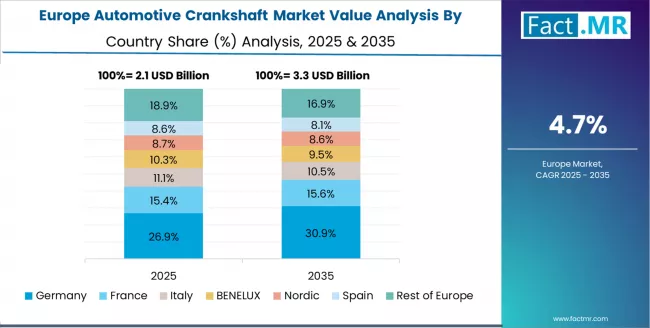
Europe’s automotive crankshaft market is expected to rise from USD 2.1 billion in 2025 to USD 3.4 billion by 2035, at a 4.9% CAGR. Germany accounts for 36.2% of the market, followed by the UK (21.4%), France (16.8%), Italy (13.7%), and Spain (8.3%). The remainder of Europe—comprising Nordic and Eastern European nations—is seeing increased adoption through modernization and digital transformation programs.
According to the European Automobile Manufacturers Association (ACEA), regional competitiveness depends on innovation funding, emissions compliance, and supply chain digitization. The European Commission’s Fit for 55 package is prompting OEMs and suppliers to integrate sustainability metrics directly into production decisions, reshaping procurement priorities across the supply chain.
Crankshaft producers in Italy and Spain are increasingly transitioning toward hybrid-compatible systems, supported by local R&D clusters and EU-backed funding for lightweight material applications. The Nordic countries, particularly Sweden and Finland, are leveraging their green steel industries to develop carbon-neutral crankshaft production pathways, enhancing Europe’s collective sustainability credentials.
Regional Competitiveness Highlights:
- EU sustainability mandates driving supply-chain transformation
- R&D funding supporting hybrid and EV component design
- Growing investment in digital twins and real-time production analytics
Competitive Landscape of the Automotive Crankshaft Market

- Leading Company Share: Schaeffler AG: 16% share
- Structure: ~15-18 credible players; top 4-6 hold ~52-57% by revenue.
- Leadership is maintained through: distribution networks, technology innovation, and product development (crankshaft performance + durability + manufacturing integration).
- What's commoditizing: basic forging processes and standard machining systems.
- Margin Opportunities: custom crankshaft services, system integration, and incorporation into automotive workflows (manufacturing protocols, performance monitoring).
| Stakeholder | What they actually control | Typical strengths | Typical blind spots |
|---|---|---|---|
| Global brands | Distribution reach, broad product catalogs, brand recognition | Wide availability, proven performance, multi-region support | Product refresh cycles; customer dependency on brand validation |
| Technology innovators | Crankshaft R&D; advanced forging formulations; enhanced manufacturing properties | Latest technologies first; attractive ROI on performance effectiveness | Service density outside core regions; scaling complexity |
| Regional specialists | Local compliance, fast delivery, nearby customer support | "Close to customer" support; pragmatic pricing; local regulations | Technology gaps; talent retention in customer service |
| Full-service providers | Complete crankshaft programs, system integration, performance monitoring | Lowest operational risk; comprehensive support | Service costs if overpromised; technology obsolescence |
| Niche specialists | Specialized applications, custom formulations, technical services | Win premium applications; flexible configurations | Scalability limitations; narrow market focus |
Key Players in the Automotive Crankshaft Market
- Schaeffler AG
- Mahle GmbH
- Aisin Corporation
- Thyssenkrupp AG
- Tenneco Inc.
- Nippon Steel Corporation
- Federal-Mogul Corporation
- Bharat Forge Limited
- CIE Automotive
- Linamar Corporation
- Metalcastello S.p.A
- Kspg AG
Scope of the Report
| Item | Value |
|---|---|
| Quantitative Units | USD 8.7 billion |
| Application | Passenger Vehicles, Commercial Vehicles, Motorcycle Engines, Marine Engines, Industrial Engines, Agricultural Equipment |
| End Use | Automotive Manufacturing, Engine Assembly Plants, Aftermarket Service Providers, Marine Manufacturers, Industrial Equipment Producers |
| Regions Covered | North America, Latin America, Western Europe, Eastern Europe, Asia Pacific, South Asia, Middle East & Africa |
| Countries Covered | China, India, Germany, Brazil, USA, UK, Japan, Canada, France, Australia, and 25+ additional countries |
| Key Companies Profiled | Schaeffler AG, Mahle GmbH, Aisin Corporation, Thyssenkrupp AG, Tenneco Inc., Nippon Steel Corporation, Federal-Mogul Corporation |
| Additional Attributes | Dollar sales by application and end-use categories, regional adoption trends across Asia Pacific, North America, and Europe, competitive landscape with crankshaft manufacturers and system integrators, automotive operator preferences for crankshaft effectiveness and performance control, integration with production platforms and quality management systems, innovations in forging technology and performance enhancement, and development of advanced crankshaft solutions with enhanced durability and operational optimization capabilities. |
Automotive Crankshaft Market by Segments
-
Application :
- Passenger Vehicles
- Commercial Vehicles
- Motorcycle Engines
- Marine Engines
- Industrial Engines
- Agricultural Equipment
-
End Use :
- Automotive Manufacturing
- Engine Assembly Plants
- Aftermarket Service Providers
- Marine Manufacturers
- Industrial Equipment Producers
-
Technology :
- Forged Steel Crankshafts
- Cast Iron Systems
- Composite Materials
-
Region :
- North America
- USA
- Canada
- Mexico
- Latin America
- Brazil
- Chile
- Rest of Latin America
- Western Europe
- Germany
- UK
- France
- Italy
- Spain
- Nordic
- BENELUX
- Rest of Western Europe
- Eastern Europe
- Russia
- Poland
- Rest of Eastern Europe
- Asia Pacific
- China
- Japan
- South Korea
- India
- Australia & New Zealand
- ASEAN
- Rest of Asia Pacific
- South Asia
- India
- Rest of South Asia
- Middle East & Africa
- Kingdom of Saudi Arabia
- Other GCC Countries
- Turkey
- South Africa
- Other African Union
- Rest of Middle East & Africa
- North America
Table of Content
- Executive Summary
- Global Market Outlook
- Demand to side Trends
- Supply to side Trends
- Technology Roadmap Analysis
- Analysis and Recommendations
- Market Overview
- Market Coverage / Taxonomy
- Market Definition / Scope / Limitations
- Market Background
- Market Dynamics
- Drivers
- Restraints
- Opportunity
- Trends
- Scenario Forecast
- Demand in Optimistic Scenario
- Demand in Likely Scenario
- Demand in Conservative Scenario
- Opportunity Map Analysis
- Product Life Cycle Analysis
- Supply Chain Analysis
- Investment Feasibility Matrix
- Value Chain Analysis
- PESTLE and Porter’s Analysis
- Regulatory Landscape
- Regional Parent Market Outlook
- Production and Consumption Statistics
- Import and Export Statistics
- Market Dynamics
- Global Market Analysis 2020 to 2024 and Forecast, 2025 to 2035
- Historical Market Size Value (USD Million) Analysis, 2020 to 2024
- Current and Future Market Size Value (USD Million) Projections, 2025 to 2035
- Y to o to Y Growth Trend Analysis
- Absolute $ Opportunity Analysis
- Global Market Pricing Analysis 2020 to 2024 and Forecast 2025 to 2035
- Global Market Analysis 2020 to 2024 and Forecast 2025 to 2035, By Application
- Introduction / Key Findings
- Historical Market Size Value (USD Million) Analysis By Application , 2020 to 2024
- Current and Future Market Size Value (USD Million) Analysis and Forecast By Application , 2025 to 2035
- Passenger Vehicles
- Commercial Vehicles
- Motorcycle Engines
- Marine Engines
- Industrial Engines
- Agricultural Equipment
- Y to o to Y Growth Trend Analysis By Application , 2020 to 2024
- Absolute $ Opportunity Analysis By Application , 2025 to 2035
- Global Market Analysis 2020 to 2024 and Forecast 2025 to 2035, By End Use
- Introduction / Key Findings
- Historical Market Size Value (USD Million) Analysis By End Use, 2020 to 2024
- Current and Future Market Size Value (USD Million) Analysis and Forecast By End Use, 2025 to 2035
- Automotive Manufacturing
- Engine Assembly Plants
- Aftermarket Service Providers
- Marine Manufacturers
- Industrial Equipment Producers
- Y to o to Y Growth Trend Analysis By End Use, 2020 to 2024
- Absolute $ Opportunity Analysis By End Use, 2025 to 2035
- Global Market Analysis 2020 to 2024 and Forecast 2025 to 2035, By Region
- Introduction
- Historical Market Size Value (USD Million) Analysis By Region, 2020 to 2024
- Current Market Size Value (USD Million) Analysis and Forecast By Region, 2025 to 2035
- North America
- Latin America
- Western Europe
- Eastern Europe
- East Asia
- South Asia and Pacific
- Middle East & Africa
- Market Attractiveness Analysis By Region
- North America Market Analysis 2020 to 2024 and Forecast 2025 to 2035, By Country
- Historical Market Size Value (USD Million) Trend Analysis By Market Taxonomy, 2020 to 2024
- Market Size Value (USD Million) Forecast By Market Taxonomy, 2025 to 2035
- By Country
- USA
- Canada
- Mexico
- By Application
- By End Use
- By Country
- Market Attractiveness Analysis
- By Country
- By Application
- By End Use
- Key Takeaways
- Latin America Market Analysis 2020 to 2024 and Forecast 2025 to 2035, By Country
- Historical Market Size Value (USD Million) Trend Analysis By Market Taxonomy, 2020 to 2024
- Market Size Value (USD Million) Forecast By Market Taxonomy, 2025 to 2035
- By Country
- Brazil
- Chile
- Rest of Latin America
- By Application
- By End Use
- By Country
- Market Attractiveness Analysis
- By Country
- By Application
- By End Use
- Key Takeaways
- Western Europe Market Analysis 2020 to 2024 and Forecast 2025 to 2035, By Country
- Historical Market Size Value (USD Million) Trend Analysis By Market Taxonomy, 2020 to 2024
- Market Size Value (USD Million) Forecast By Market Taxonomy, 2025 to 2035
- By Country
- Germany
- UK
- Italy
- Spain
- France
- Nordic
- BENELUX
- Rest of Western Europe
- By Application
- By End Use
- By Country
- Market Attractiveness Analysis
- By Country
- By Application
- By End Use
- Key Takeaways
- Eastern Europe Market Analysis 2020 to 2024 and Forecast 2025 to 2035, By Country
- Historical Market Size Value (USD Million) Trend Analysis By Market Taxonomy, 2020 to 2024
- Market Size Value (USD Million) Forecast By Market Taxonomy, 2025 to 2035
- By Country
- Russia
- Poland
- Hungary
- Balkan & Baltic
- Rest of Eastern Europe
- By Application
- By End Use
- By Country
- Market Attractiveness Analysis
- By Country
- By Application
- By End Use
- Key Takeaways
- East Asia Market Analysis 2020 to 2024 and Forecast 2025 to 2035, By Country
- Historical Market Size Value (USD Million) Trend Analysis By Market Taxonomy, 2020 to 2024
- Market Size Value (USD Million) Forecast By Market Taxonomy, 2025 to 2035
- By Country
- China
- Japan
- South Korea
- By Application
- By End Use
- By Country
- Market Attractiveness Analysis
- By Country
- By Application
- By End Use
- Key Takeaways
- South Asia and Pacific Market Analysis 2020 to 2024 and Forecast 2025 to 2035, By Country
- Historical Market Size Value (USD Million) Trend Analysis By Market Taxonomy, 2020 to 2024
- Market Size Value (USD Million) Forecast By Market Taxonomy, 2025 to 2035
- By Country
- India
- ASEAN
- Australia & New Zealand
- Rest of South Asia and Pacific
- By Application
- By End Use
- By Country
- Market Attractiveness Analysis
- By Country
- By Application
- By End Use
- Key Takeaways
- Middle East & Africa Market Analysis 2020 to 2024 and Forecast 2025 to 2035, By Country
- Historical Market Size Value (USD Million) Trend Analysis By Market Taxonomy, 2020 to 2024
- Market Size Value (USD Million) Forecast By Market Taxonomy, 2025 to 2035
- By Country
- Kingdom of Saudi Arabia
- Other GCC Countries
- Turkiye
- South Africa
- Other African Union
- Rest of Middle East & Africa
- By Application
- By End Use
- By Country
- Market Attractiveness Analysis
- By Country
- By Application
- By End Use
- Key Takeaways
- Key Countries Market Analysis
- USA
- Pricing Analysis
- Market Share Analysis, 2024
- By Application
- By End Use
- Canada
- Pricing Analysis
- Market Share Analysis, 2024
- By Application
- By End Use
- Mexico
- Pricing Analysis
- Market Share Analysis, 2024
- By Application
- By End Use
- Brazil
- Pricing Analysis
- Market Share Analysis, 2024
- By Application
- By End Use
- Chile
- Pricing Analysis
- Market Share Analysis, 2024
- By Application
- By End Use
- Germany
- Pricing Analysis
- Market Share Analysis, 2024
- By Application
- By End Use
- UK
- Pricing Analysis
- Market Share Analysis, 2024
- By Application
- By End Use
- Italy
- Pricing Analysis
- Market Share Analysis, 2024
- By Application
- By End Use
- Spain
- Pricing Analysis
- Market Share Analysis, 2024
- By Application
- By End Use
- France
- Pricing Analysis
- Market Share Analysis, 2024
- By Application
- By End Use
- India
- Pricing Analysis
- Market Share Analysis, 2024
- By Application
- By End Use
- ASEAN
- Pricing Analysis
- Market Share Analysis, 2024
- By Application
- By End Use
- Australia & New Zealand
- Pricing Analysis
- Market Share Analysis, 2024
- By Application
- By End Use
- China
- Pricing Analysis
- Market Share Analysis, 2024
- By Application
- By End Use
- Japan
- Pricing Analysis
- Market Share Analysis, 2024
- By Application
- By End Use
- South Korea
- Pricing Analysis
- Market Share Analysis, 2024
- By Application
- By End Use
- Russia
- Pricing Analysis
- Market Share Analysis, 2024
- By Application
- By End Use
- Poland
- Pricing Analysis
- Market Share Analysis, 2024
- By Application
- By End Use
- Hungary
- Pricing Analysis
- Market Share Analysis, 2024
- By Application
- By End Use
- Kingdom of Saudi Arabia
- Pricing Analysis
- Market Share Analysis, 2024
- By Application
- By End Use
- Turkiye
- Pricing Analysis
- Market Share Analysis, 2024
- By Application
- By End Use
- South Africa
- Pricing Analysis
- Market Share Analysis, 2024
- By Application
- By End Use
- USA
- Market Structure Analysis
- Competition Dashboard
- Competition Benchmarking
- Market Share Analysis of Top Players
- By Regional
- By Application
- By End Use
- Competition Analysis
- Competition Deep Dive
- Schaeffler AG
- Overview
- Product Portfolio
- Profitability by Market Segments (Product/Age /Sales Channel/Region)
- Sales Footprint
- Strategy Overview
- Marketing Strategy
- Product Strategy
- Channel Strategy
- Mahle GmbH
- Aisin Corporation
- Thyssenkrupp AG
- Tenneco Inc.
- Nippon Steel Corporation
- Federal-Mogul Corporation
- Bharat Forge Limited
- CIE Automotive
- Linamar Corporation
- Metalcastello S.p.A
- Kspg AG
- Schaeffler AG
- Competition Deep Dive
- Assumptions & Acronyms Used
- Research Methodology
List Of Table
- Table 1: Global Market Value (USD Million) Forecast by Region, 2020 to 2035
- Table 2: Global Market Value (USD Million) Forecast by Application , 2020 to 2035
- Table 3: Global Market Value (USD Million) Forecast by End Use, 2020 to 2035
- Table 4: North America Market Value (USD Million) Forecast by Country, 2020 to 2035
- Table 5: North America Market Value (USD Million) Forecast by Application , 2020 to 2035
- Table 6: North America Market Value (USD Million) Forecast by End Use, 2020 to 2035
- Table 7: Latin America Market Value (USD Million) Forecast by Country, 2020 to 2035
- Table 8: Latin America Market Value (USD Million) Forecast by Application , 2020 to 2035
- Table 9: Latin America Market Value (USD Million) Forecast by End Use, 2020 to 2035
- Table 10: Western Europe Market Value (USD Million) Forecast by Country, 2020 to 2035
- Table 11: Western Europe Market Value (USD Million) Forecast by Application , 2020 to 2035
- Table 12: Western Europe Market Value (USD Million) Forecast by End Use, 2020 to 2035
- Table 13: Eastern Europe Market Value (USD Million) Forecast by Country, 2020 to 2035
- Table 14: Eastern Europe Market Value (USD Million) Forecast by Application , 2020 to 2035
- Table 15: Eastern Europe Market Value (USD Million) Forecast by End Use, 2020 to 2035
- Table 16: East Asia Market Value (USD Million) Forecast by Country, 2020 to 2035
- Table 17: East Asia Market Value (USD Million) Forecast by Application , 2020 to 2035
- Table 18: East Asia Market Value (USD Million) Forecast by End Use, 2020 to 2035
- Table 19: South Asia and Pacific Market Value (USD Million) Forecast by Country, 2020 to 2035
- Table 20: South Asia and Pacific Market Value (USD Million) Forecast by Application , 2020 to 2035
- Table 21: South Asia and Pacific Market Value (USD Million) Forecast by End Use, 2020 to 2035
- Table 22: Middle East & Africa Market Value (USD Million) Forecast by Country, 2020 to 2035
- Table 23: Middle East & Africa Market Value (USD Million) Forecast by Application , 2020 to 2035
- Table 24: Middle East & Africa Market Value (USD Million) Forecast by End Use, 2020 to 2035
List Of Figures
- Figure 1: Global Market Pricing Analysis
- Figure 2: Global Market Value (USD Million) Forecast 2020-2035
- Figure 3: Global Market Value Share and BPS Analysis by Application , 2025 and 2035
- Figure 4: Global Market Y to o to Y Growth Comparison by Application , 2025-2035
- Figure 5: Global Market Attractiveness Analysis by Application
- Figure 6: Global Market Value Share and BPS Analysis by End Use, 2025 and 2035
- Figure 7: Global Market Y to o to Y Growth Comparison by End Use, 2025-2035
- Figure 8: Global Market Attractiveness Analysis by End Use
- Figure 9: Global Market Value (USD Million) Share and BPS Analysis by Region, 2025 and 2035
- Figure 10: Global Market Y to o to Y Growth Comparison by Region, 2025-2035
- Figure 11: Global Market Attractiveness Analysis by Region
- Figure 12: North America Market Incremental Dollar Opportunity, 2025-2035
- Figure 13: Latin America Market Incremental Dollar Opportunity, 2025-2035
- Figure 14: Western Europe Market Incremental Dollar Opportunity, 2025-2035
- Figure 15: Eastern Europe Market Incremental Dollar Opportunity, 2025-2035
- Figure 16: East Asia Market Incremental Dollar Opportunity, 2025-2035
- Figure 17: South Asia and Pacific Market Incremental Dollar Opportunity, 2025-2035
- Figure 18: Middle East & Africa Market Incremental Dollar Opportunity, 2025-2035
- Figure 19: North America Market Value Share and BPS Analysis by Country, 2025 and 2035
- Figure 20: North America Market Value Share and BPS Analysis by Application , 2025 and 2035
- Figure 21: North America Market Y to o to Y Growth Comparison by Application , 2025-2035
- Figure 22: North America Market Attractiveness Analysis by Application
- Figure 23: North America Market Value Share and BPS Analysis by End Use, 2025 and 2035
- Figure 24: North America Market Y to o to Y Growth Comparison by End Use, 2025-2035
- Figure 25: North America Market Attractiveness Analysis by End Use
- Figure 26: Latin America Market Value Share and BPS Analysis by Country, 2025 and 2035
- Figure 27: Latin America Market Value Share and BPS Analysis by Application , 2025 and 2035
- Figure 28: Latin America Market Y to o to Y Growth Comparison by Application , 2025-2035
- Figure 29: Latin America Market Attractiveness Analysis by Application
- Figure 30: Latin America Market Value Share and BPS Analysis by End Use, 2025 and 2035
- Figure 31: Latin America Market Y to o to Y Growth Comparison by End Use, 2025-2035
- Figure 32: Latin America Market Attractiveness Analysis by End Use
- Figure 33: Western Europe Market Value Share and BPS Analysis by Country, 2025 and 2035
- Figure 34: Western Europe Market Value Share and BPS Analysis by Application , 2025 and 2035
- Figure 35: Western Europe Market Y to o to Y Growth Comparison by Application , 2025-2035
- Figure 36: Western Europe Market Attractiveness Analysis by Application
- Figure 37: Western Europe Market Value Share and BPS Analysis by End Use, 2025 and 2035
- Figure 38: Western Europe Market Y to o to Y Growth Comparison by End Use, 2025-2035
- Figure 39: Western Europe Market Attractiveness Analysis by End Use
- Figure 40: Eastern Europe Market Value Share and BPS Analysis by Country, 2025 and 2035
- Figure 41: Eastern Europe Market Value Share and BPS Analysis by Application , 2025 and 2035
- Figure 42: Eastern Europe Market Y to o to Y Growth Comparison by Application , 2025-2035
- Figure 43: Eastern Europe Market Attractiveness Analysis by Application
- Figure 44: Eastern Europe Market Value Share and BPS Analysis by End Use, 2025 and 2035
- Figure 45: Eastern Europe Market Y to o to Y Growth Comparison by End Use, 2025-2035
- Figure 46: Eastern Europe Market Attractiveness Analysis by End Use
- Figure 47: East Asia Market Value Share and BPS Analysis by Country, 2025 and 2035
- Figure 48: East Asia Market Value Share and BPS Analysis by Application , 2025 and 2035
- Figure 49: East Asia Market Y to o to Y Growth Comparison by Application , 2025-2035
- Figure 50: East Asia Market Attractiveness Analysis by Application
- Figure 51: East Asia Market Value Share and BPS Analysis by End Use, 2025 and 2035
- Figure 52: East Asia Market Y to o to Y Growth Comparison by End Use, 2025-2035
- Figure 53: East Asia Market Attractiveness Analysis by End Use
- Figure 54: South Asia and Pacific Market Value Share and BPS Analysis by Country, 2025 and 2035
- Figure 55: South Asia and Pacific Market Value Share and BPS Analysis by Application , 2025 and 2035
- Figure 56: South Asia and Pacific Market Y to o to Y Growth Comparison by Application , 2025-2035
- Figure 57: South Asia and Pacific Market Attractiveness Analysis by Application
- Figure 58: South Asia and Pacific Market Value Share and BPS Analysis by End Use, 2025 and 2035
- Figure 59: South Asia and Pacific Market Y to o to Y Growth Comparison by End Use, 2025-2035
- Figure 60: South Asia and Pacific Market Attractiveness Analysis by End Use
- Figure 61: Middle East & Africa Market Value Share and BPS Analysis by Country, 2025 and 2035
- Figure 62: Middle East & Africa Market Value Share and BPS Analysis by Application , 2025 and 2035
- Figure 63: Middle East & Africa Market Y to o to Y Growth Comparison by Application , 2025-2035
- Figure 64: Middle East & Africa Market Attractiveness Analysis by Application
- Figure 65: Middle East & Africa Market Value Share and BPS Analysis by End Use, 2025 and 2035
- Figure 66: Middle East & Africa Market Y to o to Y Growth Comparison by End Use, 2025-2035
- Figure 67: Middle East & Africa Market Attractiveness Analysis by End Use
- Figure 68: Global Market - Tier Structure Analysis
- Figure 69: Global Market - Company Share Analysis
- FAQs -
How big is the automotive crankshaft market in 2025?
The global automotive crankshaft market is estimated to be valued at USD 8.7 billion in 2025.
What will be the size of automotive crankshaft market in 2035?
The market size for the automotive crankshaft market is projected to reach USD 14.2 billion by 2035.
How much will be the automotive crankshaft market growth between 2025 and 2035?
The automotive crankshaft market is expected to grow at a 5.0% CAGR between 2025 and 2035.
What are the key product types in the automotive crankshaft market?
The key product types in automotive crankshaft market are passenger vehicles, commercial vehicles, motorcycle engines, marine engines, industrial engines and agricultural equipment.
Which end use segment to contribute significant share in the automotive crankshaft market in 2025?
In terms of end use, automotive manufacturing segment to command 61.0% share in the automotive crankshaft market in 2025.